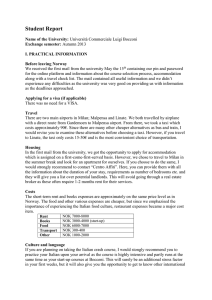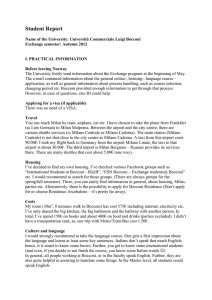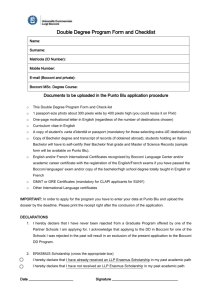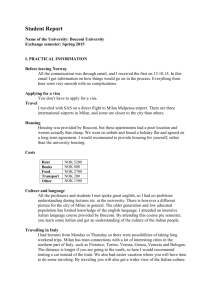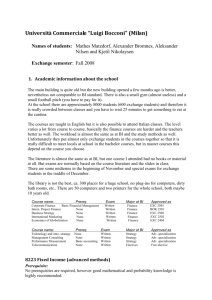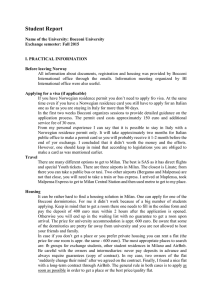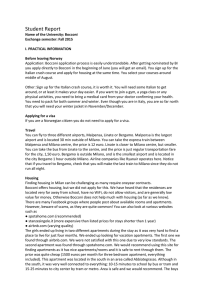Student Report
advertisement
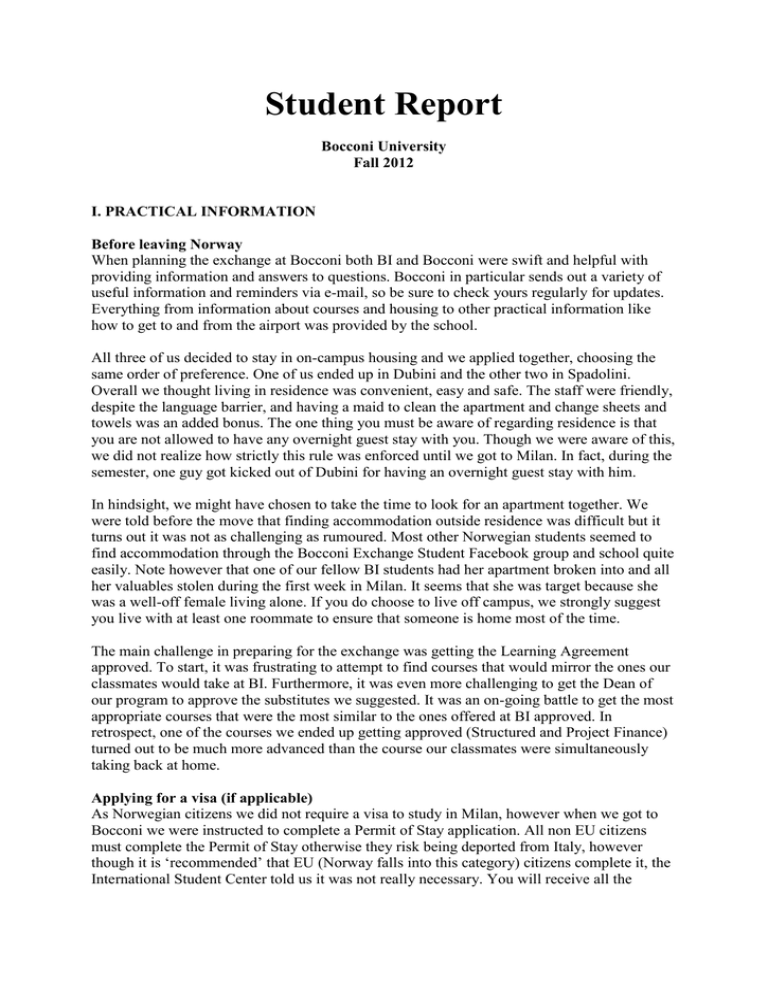
Student Report Bocconi University Fall 2012 I. PRACTICAL INFORMATION Before leaving Norway When planning the exchange at Bocconi both BI and Bocconi were swift and helpful with providing information and answers to questions. Bocconi in particular sends out a variety of useful information and reminders via e-mail, so be sure to check yours regularly for updates. Everything from information about courses and housing to other practical information like how to get to and from the airport was provided by the school. All three of us decided to stay in on-campus housing and we applied together, choosing the same order of preference. One of us ended up in Dubini and the other two in Spadolini. Overall we thought living in residence was convenient, easy and safe. The staff were friendly, despite the language barrier, and having a maid to clean the apartment and change sheets and towels was an added bonus. The one thing you must be aware of regarding residence is that you are not allowed to have any overnight guest stay with you. Though we were aware of this, we did not realize how strictly this rule was enforced until we got to Milan. In fact, during the semester, one guy got kicked out of Dubini for having an overnight guest stay with him. In hindsight, we might have chosen to take the time to look for an apartment together. We were told before the move that finding accommodation outside residence was difficult but it turns out it was not as challenging as rumoured. Most other Norwegian students seemed to find accommodation through the Bocconi Exchange Student Facebook group and school quite easily. Note however that one of our fellow BI students had her apartment broken into and all her valuables stolen during the first week in Milan. It seems that she was target because she was a well-off female living alone. If you do choose to live off campus, we strongly suggest you live with at least one roommate to ensure that someone is home most of the time. The main challenge in preparing for the exchange was getting the Learning Agreement approved. To start, it was frustrating to attempt to find courses that would mirror the ones our classmates would take at BI. Furthermore, it was even more challenging to get the Dean of our program to approve the substitutes we suggested. It was an on-going battle to get the most appropriate courses that were the most similar to the ones offered at BI approved. In retrospect, one of the courses we ended up getting approved (Structured and Project Finance) turned out to be much more advanced than the course our classmates were simultaneously taking back at home. Applying for a visa (if applicable) As Norwegian citizens we did not require a visa to study in Milan, however when we got to Bocconi we were instructed to complete a Permit of Stay application. All non EU citizens must complete the Permit of Stay otherwise they risk being deported from Italy, however though it is ‘recommended’ that EU (Norway falls into this category) citizens complete it, the International Student Center told us it was not really necessary. You will receive all the information necessary regarding this from Bocconi and once you’ve reviewed it you can decide for yourself how you wish to proceed. Travel Travelling to and from Milan is convenient and affordable. The city has three airports, Malpensa (approximately 1 hour from downtown), Bergamo/Orio al Serio (approximately 1 hour from downtown) and Linate (approximately 20 minutes from downtown), which are serviced by a variety of airlines. On the way to Milan, two of us flew RyanAir from Torp and one flew SAS via Copenhagen from Gardermoen. On the way home, all three took a Norwegian flight from Malpensa to Gardermoen. Transportation to and from the airport is really convenient and affordable as one can take shuttle busses from different locations downtown to the airports. There is also an express train from one of the Cadorna train station to Malpensa which takes 30 minutes and cost 11Euro. Housing As previously mentioned, several near campus residence options are provided for housing. Information about the housing choices and the application process is provided by Bocconi via e-mail. If you choose to locate housing outside campus, the best place to do so is either through the ESN Bocconi Exchange Students Facebook Group or through AirBnB. Costs Rent Books Food Transport Other NOK 4500-5500 / month NOK 1000-2000 total NOK 1500-2000 / month NOK 220/month (metropass for over age 26 years) NOK 125/month (metropass for under 26 years) NOK 70-140 per taxi ride Culture and language With regards to language and culture it should be noted that Italians are quite different in both aspects from northern Europeans. Most young people around our age speak English, however older generations have minimal skills in any language other than Italian. To overcome this barrier you should take an active interest in learning at least the key words and phrases used daily in Italy. Downloading a translation application to your smartphone, for example Google Translate, proved of great use in a variety of situations, from the metro to the post office. All three of us chose to enrol in the Italian crash course at the beginning of the semester. Although we agree that the course was a little too intense and more advanced than necessary, and provided less focus on daily phrases and useful vocabulary, our Italian got off to a good start with the course. If anything we at least developed the ability to pronounce words and letters properly. Added bonus is that we met a variety of other exchange students in our course. Overall at Bocconi, the staff, professors and students speak decent English. The International Student Office is in particular very helpful if you have any questions or concerns. They are located on campus and can be visited or reached by phone or e-mail. If you take an active interest in Italian culture, you can experience and learn a lot from Milan and the surrounding areas. Most weekends we went on missions to explore either Milan or cities nearby. Between the three of us we visited the following Italian places while on exchange: Lake Como, Torino, Florence, Tuscany, Rome, Venice, Verona, Pisa, Cinque Terre and Portofino. We also travelled outside Italy to among other places Munich for Octoberfest, Paris for Pitchfork Music Festival and Madrid. Within Milan we visited among others the following sites and attractions: - Duomo di Milano - Galleria Vittorio Emanuele II - Brera Picture Gallery - Castello Sforzesco - Parco Sempione - Teatro alla Scala - Palazzo Reale - Quadrilatero d'Oro (Rectangle of Gold – Shopping area) - Museo del Novecento - Museo Nazionale della Scienza e della Technologia - Colonne di San Lorenzo - Giardini Pubblici - San Siro Stadium - Antiquariato sul Naviglio Grande - Fiera di Senigallia - Mercato di Vivale Papiniano - Last Supper Painting in Santa Maria della Grazie - Basilica Sant'Ambrogio - Forma Gallery - Pirelli Tower Cultural and social effects from the exchange experience Overall the exchange experience has made us even more open and accepting of other cultures. We’ve learnt to be more diplomatic, patient and understanding in what can sometimes be experienced as frustrating and challenging situations. With an increasingly global and international work force, this experience will aid us in our future careers by allowing us to utilize the skills we’ve learned in a professional setting. II. ABOUT THE SCHOOL Bocconi University lies approximately 20 minutes walking distance south of downtown Milan. The school area is not that big in size as it has three main buildings and it is easy to get around within the area between classrooms, library, canteen and offices. Bocconi provides undergraduate, graduate and post-graduate education, in addition to a range of double degree programs, in the fields of Economics, Management, Finance, Law and Public Administration, According to many University rankings, the university is among the top business schools in the world. The university has 14,300 students attending in total. The one thing that has been frustrating is the lack of study rooms/areas. Many of us have sat at home or been forced to work at different libraries downtown due to few study rooms. Bocconi has two canteens on campus, one of them is much better than the other since it offers more dishes, it has a more open landscape and in general a more efficient system. If you are an exchange student you get the opportunity to purchase half priced food in the canteen (4,10 Euros instead of 7,20 Euro) If you choose to use your Bocconi card for the canteen, you receive an exchange deal for 40 Euro, which contain 10 clips (This for both canteens). We received information about this in the welcome package the first day of school and highly recommend purchasing the deal. Besides this you will also find a lot of restaurants near school which offer good food for a fairly decent amount of money. As well, Bocconi is close to the Navigli area, where you can find a lot of nice restaurants and bars. Course registration In Bocconi it is mandatory to register your courses in advance. The register date was from August 21-30, as school started September 10th. (The Italian crash course officially started 3rd of September) The information provided by the International office in Bocconi was both clear and helpful so we faced no problems with the course registration. Note that it is possible to change your courses if you have second thoughts and the dates for this were September 1220 of September. Keep in mind that in order to secure that you are signed up for the courses that are most suitable for you, we recommend registering for your courses as soon as registration opens. Academic calendar Arrival date: First day of the semester: Last day of classes: Examination period: Any special events/holidays: August 31st September 3rd November 30th December 3rd-21st December 7th (Sant'Ambrogio) Arrival As we were three students that know each other from BI we planned the arrival date together, although we travelled with 2 different flights we arrived the same date. Here we did not face any difficulties at any level. When we arrived to our dorms we showed our passport and “acceptance of stay” and we were shown to our rooms. Although the dorms are under school property Bocconi did not know of our arrival at this specific date. The international office informed us through e-mail long time in advance that it was possible to check in from 31st of August. This date was appropriate for us since the Italian crash course started 3rd of September and we though it would be nice to arrive in Milan a few days before school started. The international week lasted the first two weeks, from 3rd to 16th of September and there were many different events organized during these 14 days. The ESN (Erasmus Student Network) arranged and organized gatherings such as aperitivos, dinners, day trips and other cultural happenings almost every day for new Bocconi students. This was a social and fun start to our Bocconi student life and we quickly got to know new people starting day one. We strongly recommend participating in some of these events as it open up your network and it is easy to get new acquaintances from different countries/cultures. Overall the international weeks were exciting and fun and a really efficient way to establish new friendships. The International Office The international office at Bocconi has always been a very helpful and accommodating if any questions arise of problems occurs. They speak very well English and our experience with them is that they are both trustworthy and supportive. We have not been in need to meet them more than once when the slides from a course we attended did not upload on the online platform we use. When we contacted them regarding this issue, it was solved right away. In addition, throughout our stay they have been distributing relevant and clear information through e-mail in English. Social activities When it comes to the social life during exchange it is what you make of it yourself, this pertains also at Bocconi. The relationship between students abroad generally tends to be very good, and this is also something we have seen here in Milan. You are highly interdependent abroad, which is fun, interesting and you learn to know yourself better. We have been hanging out in a large group with a mix of nationalities mainly from Scandinavia, Italy and the United States. It is also worth mentioning that if you want to prioritize to enhance you international environment while being abroad it is more suitable to accommodate on a dorm than renting accommodation privately. In the dorms you will find all kinds of nationalities and this has been a fun part of our lives abroad. Spadolini, which is the dorm where two of us lived, is the home of mostly Italians. Dubini on the other hand accommodate mostly exchange students. This has clearly created a more international environment for our 4 month stay in Milan. Throughout the semester, ESN Bocconi arranged several social gatherings such as student parties, cultural events, day trip to Lake Como, weekend trip to different locations e.g. Venice, Munich, Tuscany etc. We did not participate in too many of these events because we heard that one of the trips did not met the expectations of students as it was not properly planned and it involved a lot of waiting. With the help of our Italian friends we arranged our own trips with a smaller group. Another idea to boost your social life abroad is to engage in a student association of some kind. Bocconi provides several different kinds of student unions and offers students many fields to engage in, such as sports unions, career days and more unions related to the local community. Here you have the chance to open your network and leverage these unions, which pertain for all undergraduates, graduates, and exchange students. However, none of us got involved in any of these associations, so therefore we do not have any further information about them. The Unibocconi.it website accurately explains the different unions you can join and participate in. This is also a great channel of information as it contains the latest news related to Bocconi. III. ACADEMICS In the classroom The teaching styles have been very varied; some lecturers prefer cases and a high level of student-professor interaction during class while others chose standard style of lecturing with a power point presentation. In some classes there have also been guest speakers, who hold senior and important positions in Italian/European business. The lessons have been very practical especially in financial courses and the level of English is quite good. Professorstudent relationships are similar to those at BI and the workload has also been comparable to BI. The relation among students in class depends a lot on what you want it to be. For group assignments you are free to form your own group, but if you can’t or won’t, the professor will assign you to one. Note that there exists the option to take courses as a non-attending student. This means that you are not required to complete any of the course work except the final exam, which will then count for 100% of your grade. If you choose to be a non-attending student, you must notify the professor at the very beginning of the course. Course materials Most courses have textbooks, but some only utilize slides and articles. Books are often written by the lecturers themselves and overall hold a high quality. All course material was given in English and available online. In general, the material provided held a higher level than that at BI and it was used for both broad and detailed knowledge of subjects. Exams Exams were based mainly on lectures, both those of guests and the main professor. Most courses have an hour long written exam and some had also assignments and presentations. There were no mid-term exams in any of our courses. Students also have the option to participate in different simulation games at the computer lab, however without a grade being assigned. In addition, no attendance is taken. Library and technology None of us have utilized the library for borrowing material, only for the study rooms or the copy machines. The computer labs at Bocconi are horrible; outdated and incredibly slow. If you need to work on a computer we recommend bringing your own laptop to school. Students do however have the ability to print at lower rates than at BI. Note that when you use the computer lab, you must sign in with the person manning the room. The person will assign you a computer number and this is the computer you must use. You also need to sign out when you leave. Online sites are used to sign up for exams, information, and receiving material. There are three different online platforms for teachers to share material online, which can be frustrating and confusing at times. Description of courses Course code & name Master/ Bachelor Exam form Prerequisites Approved as Comments 20237 – Management of Fashion and Luxury Companies Master 60 minutes written multiple choice and short answer None BI management course 20319 – Change Management 20349 – Structured and Project Finance Master 75 minutes written 90 minutes written None BI management course BI finance course Very fun and interesting course. Professor is highly knowledgeable about the industry Overall an okay course Master None Very advanced and challenging. Recommend having a strong interest or a lot of background knowledge 20430 – Digital Marketing and E-Commerce Advanced Master 8307 – Mergers and Acquisitions Master 45 minutes written multiple choice and short answer 90 minutes written None Elective Was taken as a ‘non-attending student’ so no additional comments available None Elective Very good professor and guest lectures. Any other experiences/comments about your exchange experience?: It’s been really great and we recommend anyone who is interested to apply and experience a semester at Bocconi.
